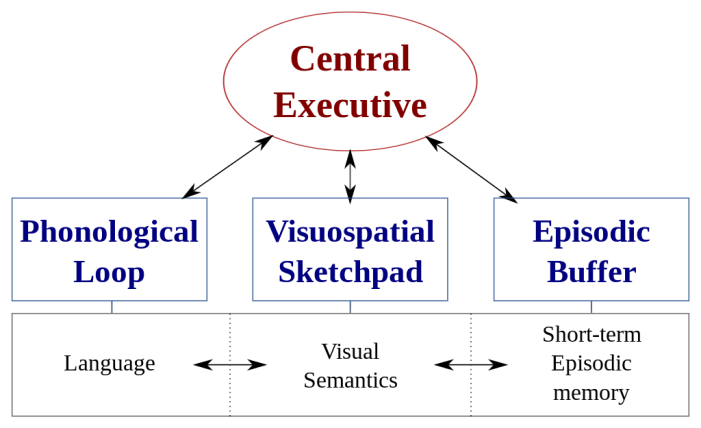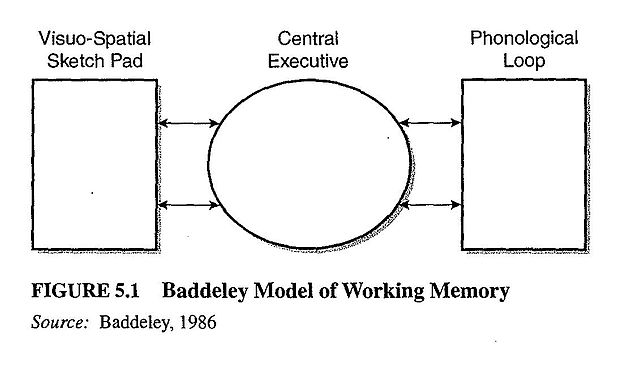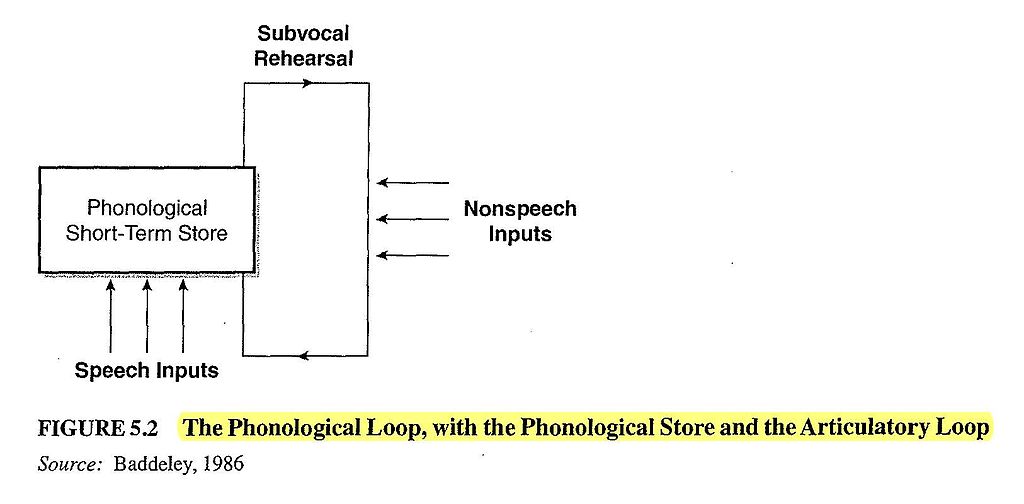Baddeley’s Model of Working Memory is a widely recognized and influential theory in the field of cognitive psychology. Proposed by Alan Baddeley in 1974, this model revolutionized our understanding of short-term memory and its role in human cognition. The model suggests that working memory is a dynamic system that consists of multiple components and functions, which work together to process and manipulate information. In this introduction, we will explore the components and functions of Baddeley’s Model of Working Memory and how they contribute to our understanding of human memory and cognitive processes.

Schematic of Baddeley’s Model
Alan Baddeley and Graham Hitch proposed a model of working memory in 1974, in an attempt to describe a more accurate model of short-term memory. Baddeley & Hitch proposed their tripartite working memory model as an alternative to the short-term store in Atkinson & Shiffrin’s ‘multi-store’ memory model (1968). This model is later expanded upon by Baddeley and other co-workers and has become the dominant view in the field of working memory. However, alternative models are developing (see working memory) providing a different perspective on the working memory system.
The original model of Baddeley & Hitch was composed of three main components; the central executive which acts as supervisory system and controls the flow of information from and to its slave systems: the phonological loop and the visuo-spatial sketchpad. The slave systems are short-term storage systems dedicated to a content domain (verbal and visuo-spatial, respectively). In 2000 Baddeley added a third slave system to his model, the episodic buffer.
Baddeley & Hitch’s argument for the distinction of two domain-specific slave systems in the older model was derived from experimental findings with dual-task paradigms. Performance of two simultaneous tasks requiring the use of two separate perceptual domains (i.e. a visual and a verbal task) is nearly as efficient as performance of the tasks individually. In contrast, when a person tries to carry out two tasks simultaneously that use the same perceptual domain, performance is less efficient than when performing the tasks individually.
Components

Baddeley’s Model of Working Memory
Central executive
The central executive is a flexible system responsible for the control and regulation of cognitive processes. It has the following functions:
- binding information from a number of sources into coherent episodes
- coordination of the slave systems
- shifting between tasks or retrieval strategies
- selective attention and inhibition
It can be thought of as a supervisory system that controls cognitive processes and intervenes when they go astray.
Using the dual-task paradigm, Baddeley and Erses have found, for instance, that patients with Alzheimer’s dementia are impaired when performing multiple tasks simultaneously, even when the difficulty of the individual tasks is adapted to their abilities.
Recent research on executive functions suggests that the ‘central’ executive is not as central as conceived in the Baddeley & Hitch model. Rather, there seem to be separate executive functions that can vary largely independently between individuals and can be selectively impaired or spared by brain damage.
Phonological loop

Baddeley’s Model of Working Memory – Phonological Loop
The phonological loop (or “articulatory loop”) as a whole deals with sound or phonological information. It consists of two parts: a short-term phonological store with auditory memory traces that are subject to rapid decay and an articulatory rehearsal component (sometimes called the articulatory loop) that can revive the memory traces.
Any auditory verbal information is assumed to enter automatically into the phonological store. Visually presented language can be transformed into phonological code by silent articulation and thereby be encoded into the phonological store. This transformation is facilitated by the articulatory control process. The phonological store acts as an ‘inner ear’, remembering speech sounds in their temporal order, whilst the articulatory process acts as an ‘inner voice’ and repeats the series of words (or other speech elements) on a loop to prevent them from decaying. The phonological loop may play a key role in the acquisition of vocabulary, particularly in the early childhood years. It may also be vital for learning a second language.
Five main findings provide evidence for the phonological loop:
- The effect of phonological similarity: Lists of words that sound similar are more difficult to remember than words that sound different. Semantic similarity (similarity of meaning) has comparatively little effect, supporting the assumption that verbal information is coded largely phonologically in working memory.
- The effect of articulatory suppression: Memory for verbal material is impaired when people are asked to say something irrelevant aloud. This is assumed to block the articulatory rehearsal process, thereby leaving memory traces in the phonological loop to decay.
- Transfer of information between codes: With visually presented items, adults usually name and sub-vocally rehearse them, so the information is transferred from a visual to an auditory code. Articulatory suppression prevents this transfer, and in that case the above mentioned effect of phonological similarity is erased for visually presented items.
- Neuropsychological evidence: A defective phonological store explains the behavior of patients with a specific deficit in phonological short-term memory. Aphasic patients with dyspraxia are unable to set up the speech motor codes necessary for articulation, caused by a deficiency of the articulatory rehearsal process.
- On the other hand, patients with dysarthria, whose speech problems are secondary, show a normal capacity for rehearsal. This suggests that it is the subvocal rehearsing that is crucial.
Evidence in Support of Phonological Short Term Store
A accumulation of literature across decades has lent strong support to the theory of phonological STS. In a 1971 study, Stephen Madigan demonstrated that a larger recency effect is seen during forward serial recall when people are presented a list auditorally as opposed to visually. (A smaller effect is seen in backwards serial recall.) In his study, auditory presentation led to greater recall of the most recently studied items. Catherine Penney expanded on this discovery to observe that modality effects can also be found in the case of free recall tasks. In 1965, Dallett had discovered that this observed modality effect is greatly reduced by the addition of a “suffix” item to the presented list; this suffix is a distractor item that is not to be recalled. Robert Greene utilized this observation in 1987 to discover that this suffix effect has a larger impact on lists learned auditorally as opposed to visually. The culmination of all of these findings results in strong support of the theory that there is a short-term store that phonologically stores recently learned items. In addition, Bloom and Watkins found that the suffix effect is greatly diminished when the suffix is not interpreted as linguistic sound, which agrees with the phonological short term store theory as it would be largely unaffected by non-linguistic distractors.
Biology
In terms of genetics, the gene ROBO1 has been associated with phonological buffer integrity or length.
Visuospatial sketchpad
The visuospatial sketchpad is assumed to hold information about what we see. It is used in the temporary storage and manipulation of spatial and visual information, such as remembering shapes and colours, or the location or speed of objects in space. It is also involved in tasks which involve planning of spatial movements, like planning one’s way through a complex building. The visuospatial sketchpad can be divided into separate visual, spatial and possibly kinaesthetic (movement) components. It is principally represented within the right hemisphere of the brain.
Logie’s elaboration of the visuospatial sketchpad
Logie has proposed that the visuospatial sketchpad can be further subdivided into two components:
- The visual cache, which stores information about form and color.
- The inner scribe, which deals with spatial and movement information. It also rehearses information in the visual cache and transfers information to the central executive.
Three main findings provide evidence for the distinction between visual and spatial parts of the visuospatial sketchpad:
- There is less interference between visual and spatial tasks than between two visual tasks or two spatial tasks.
- Brain damage can influence one of the components without influencing the other.
- Results from brain-imaging show that working memory tasks with visual objects activate mostly areas in the left hemisphere, whereas tasks with spatial information activate more areas in the right hemisphere.
Episodic buffer
In 2000 Baddeley added a fourth component to the model, called the ‘episodic buffer’. This component is a third slave system, dedicated to linking information across domains to form integrated units of visual, spatial, and verbal information with time sequencing (or chronological ordering), such as the memory of a story or a movie scene. The episodic buffer is also assumed to have links to long-term memory and semantic meaning.
The main motivation for introducing this component was the observation that some (in particular, highly intelligent) patients with amnesia, who presumably have no ability to encode new information in long-term memory, nevertheless have good short-term recall of stories, recalling much more information than could be held in the phonological loop.
Validity of the model
The strength of Baddeley’s model is its ability to integrate a large amount of findings from work on short-term and working memory. Additionally, the mechanisms of the slave systems, especially the phonological loop, has inspired a wealth of research in experimental psychology, neuropsychology, and cognitive neuroscience.
However, criticisms have been raised, for instance of the phonological-loop component, because some details of the findings are not easily explained by the original Baddeley & Hitch model.
The episodic buffer is seen as a helpful addition to the model of working memory, but it has not been investigated extensively and its functions remain unclear.